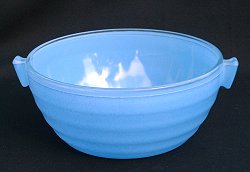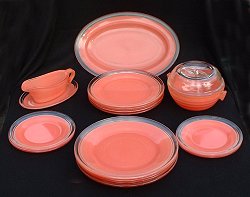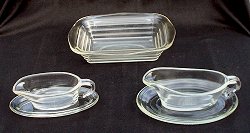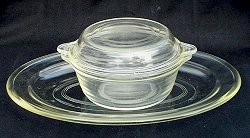 |
The British Heat Resisting Glass Company"Phoenix" |
 |
War time produced its own vicissitudes. Gwen Watts (nee
Boycott) records (letter in the "Bugle", 17th January
2002) that she knew Alec Wilfort's wife, Kathleen, very well as
she worked alongside her in the sales office. She remembers
Kathleen taking round the comforts box and that the proceeds
were spent not only on parcels for the forces but also to buy
wool from which the office staff would knit scarves, socks and
gloves to put in the parcels.
Gwen also remembers that Kathleen "was married in
my wedding dress. Clothes rationing was in force at the time and
anything which could be borrowed for a one-off occasion, saved
precious clothing coupons". This pulling together and helping
out was, of course, not uncommon in war time, but it seems to
have been in full swing in Phoenix and must have been one of
things which contributed to Gwen's conclusion that : "It was a very happy atmosphere at Phoenix - we
were like a big family - and I have some wonderful memories of
my working years there amongst some of the nicest people I've
known".
Gwen also records another war time problem and the solution found to it by Phoenix - a slightly maverick solution that may have been typical of the way Phoenix operated. "When packing materials were in short supply we were given permission to cut the heather on Cannock Chase to use for packing the glassware. Small groups of us would be taken to Cannock Chase by lorry after we'd finished our days work. We'd spend two or three hours gathering and loading the heather. With aching backs we were then taken into Cannock town for a very welcome cup of coffee at Taylor's café before heading back to Bilston. We had a lot of fun on these expeditions as well as doing our but for the war effort".

Gravy boat in a startling yellow |

arge bowl in vivid blue |

Dinner service in raspberry with clear edges |

Gravy boats and a baking dish in clear glass |
By 1941 it seems that Phoenix had to stop ordinary production and convert to war work - work which, at the time was secret. In a long interview in the Express and Star for 11th April 1964 Miss V (Freezie) Freestone, then the company's Sales Manager, was able to give details of one of their contributions to the war effort. The newly created radar system was breaking down because of poor insulation. Colonel Jell considered the matter and came up with the idea of an improved insulator, made in glass, with corrugations which gave a greater surface area. This idea, he said, came from thinking of the serrated stomach of the shark which gives a large surface area in a small space. (How the gallant colonel came to be acquainted with the stomachs of sharks is not recorded). It took him 24 hours to perfect the design.
 |
 |
| Large serving plate and casserole in clear glass | Fruit dishes, one in clear glass, the rest in pale frosted green |
As it was top secret, the insulators were blown by only one man, the master craftsman, Ralph Brown. He worked 50 hours non stop, eating while he worked, to produce sufficient insulators; and so the radar stations were equipped before the Battle of Britain started. The company also blew the cathode ray tubes which were used for the new radar system. And they also pressed glass insulators for submarines, which were needed to avoid the corrosion from which the earlier versions had suffered. More than 200 of the company's employees were called up but Freezie sent them all a weekly newsletter about the company and life on the home front.
 click above to continue the Phoenix story |